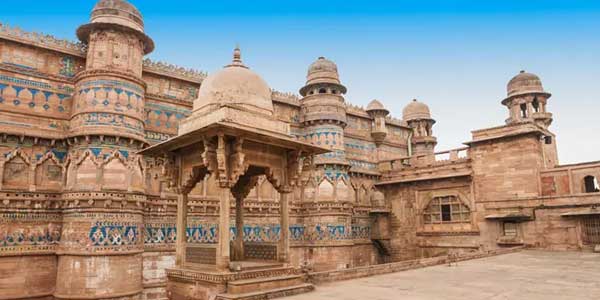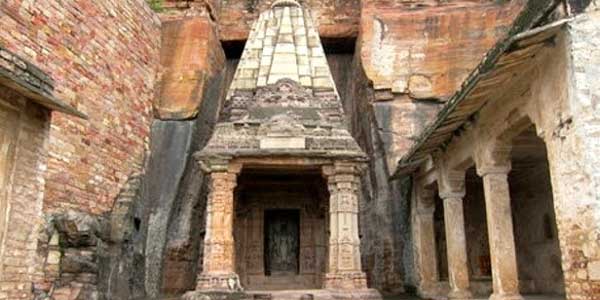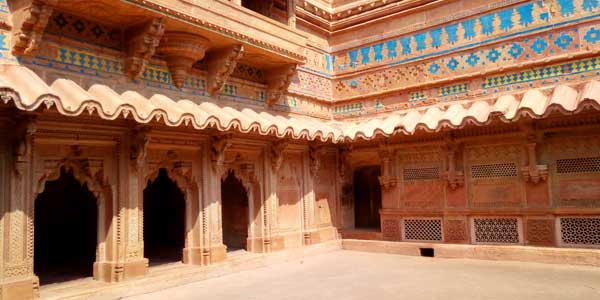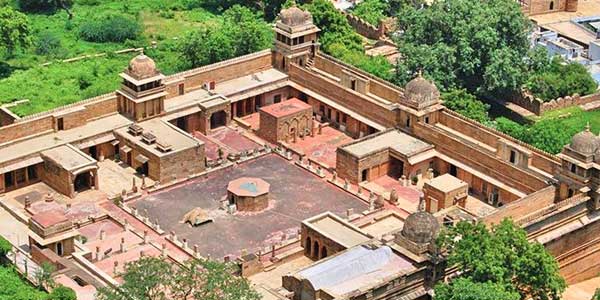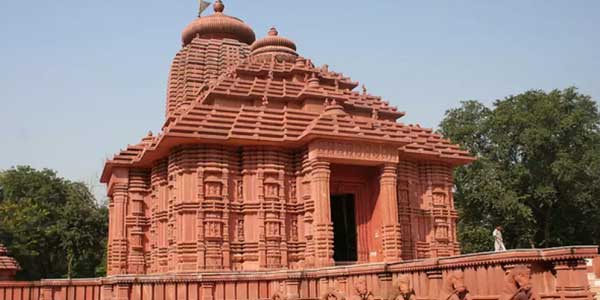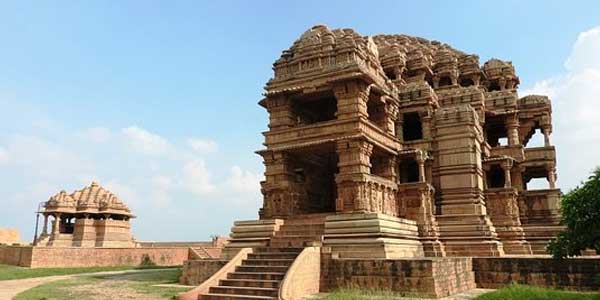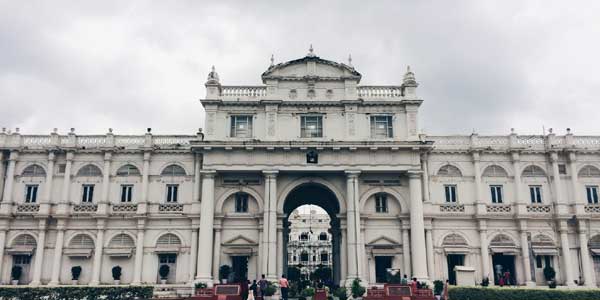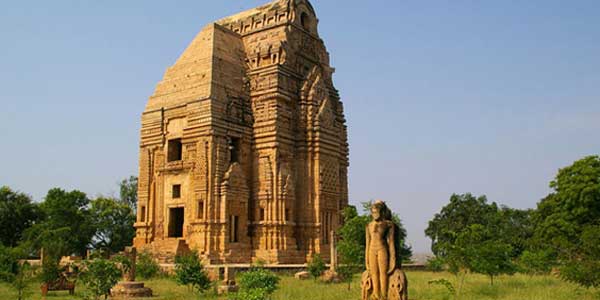
Gwalior Monuments
Gwalior Fort was built by a local king in honour of the saint who cured him of leprosy using the water from a pond. This pond is believed to be housed in the complex of the fort. Whether this stands true or not, the exact year or century of the construction of the fort remains unknown. However, one thing is certain; the fort has stood its ground since at least the 10th century. The complex houses a defensive structure and two palaces, the Gujari Mahal and Man Mandir. Both palaces are attributed to Man Singh Tomar, who ruled between 1486 CE and 1516 CE. The Gujari Mahal, which was originally meant to serve as home to Queen Mrignayni, is a museum today and houses some of the artefacts from the fort. One of the most interesting pieces in the Gwalior Fort is an inscription with a zero, which is believed to be the second oldest record of the integer’s use and dates back to over 1500 years ago. This inscription is on display in the fort’s complex on the way to the top. The authorities host a light and sound show in the evenings at Man Mandir that gives a valuable insight into the fort’s history.
History of the Fort
The construction of the fort is associated with a legend and hence, the exact date of its construction is unknown. The legend has it that a local king named Suraj Sen ruled this region in 3 CE. The king developed leprosy, a deadly disease which couldn’t be cured in those days. When the king had lost all hopes, a sage named Gwalipa came to the king’s rescue and he miraculously cured the disease by asking the king to drink water from a sacred pond (it is believed that the present pond inside the fort is the same pond that helped the king). When the king was cured, he decided to build a fort to honor the sage and also named the city after the sage, which came to be known as Gwalior. The sage conferred the king with the title ‘Pal,’ meaning protector, and promised him that his descendants would rule over the fort as long as they bear the title ‘Pal’. After this incident, many descendants of Suraj Sen Pal ruled over the fort but his 84th successor, Tej Karan, lost the possession of the fort.
There are no historical records or evidences to prove the fort’s real age. Though inscriptions within the fort indicate that the fort must have been standing here from the 6th Century, but there is no solid proof to prove the same. However, there are certain evidences that suggest the existence of the fort from the late 9th Century. One such evidence is the existence of the ‘Teli ka Mandir’, a Hindu temple said to be built by the Gurjara-Pratiharas. From 10th Century onwards, the fort was ruled over by the kings of the Kachchhapaghata dynasty.
Later History of the Fort
Around the 10th Century, many Muslim rulers tried their best to capture the fort. Mahmud of Ghazni besieged the fort in 1022 CE, but he lifted the siege when presented with 35 elephants. Qutb al-Din Aibak, the first Sultan of the Delhi Sultanate, captured the fort in 1196, only to lose it a few years later. However, Iltumish, the third ruler of the Delhi Sultanate, recaptured the fort in 1232 CE. Around 1398, the fort was captured by the Tomars and it remained with them for a long time. Raja Maan Singh Tomar constructed several structures within the fort, changing its appearance forever. Meanwhile, rulers of the Delhi Sultanate were constantly trying to recapture the fort. One such attempt by Sikander Lodi failed in 1505, but his son Ibrahim Lodi managed to capture the fort in 1516, which resulted in the death of Raja Maan Singh Tomar. The fort was, however, soon taken by Babur, the founder of the Mughal dynasty. However, the Mughals lost it to the Sur ruler Sher Shah Suri, in 1542. In 1558, Mughal Emperor Akbar recaptured the fort and turned it into a prison, where he executed his prisoners and rivals.
Post the reign of Aurangzeb, the Mughal Empire weakened, resulting in the loss of the fort, which was now captured by the Rana chieftains of Gohad. Mahadaji Shinde of the Scindia dynasty captured it from Gohad Rana Chhatar Singh, but eventually lost the fort to the British. In 1780, the British gave away the fort to the Ranas, in exchange for their support during the Sepoy Mutiny in the 18th Century. The Marathas then captured it again from the Ranas, but lost it to the British during the Second Anglo-Maratha War. The British then largely controlled the fort and sometimes even gave up its ownership to the Scindia family for political reasons. In 1886, after capturing the whole of India, the British gave the fort to the Scindias, as the fort was of little importance to them at that time. The Scindias then ruled over the fort and even came up with their own structures within the fort, until it was finally taken by the government of India post-independence.
Gwalior Monuments
Gwalior Monuments lies to the south of Agra, about 122 km. A historic town renowned for its ancient and magnificent forts and palaces, Gwalior is home to many tourist attractions worth visiting when on a tour of Madhya Pradesh to Gwalior. Gwalior's temples and museums are among the city's many tourist attractions.
Gwalior occupies an significant role in the medieval history and struggle for independence in India. The town is also renowned for being home to many of the country's respected colleges and schools. Rich in cultural heritage and architectural marvels, Gwalior was placed under the control of many dynasties of the Pratiharas, Kacchwahas and Tomars heroic Rajput clans. This city has preserved its rich cultural heritage, expressed marvelously in its palaces , temples and museums.
The Gwalior Monuments and Museums attract numerous visitors from every corner of the globe to Gwalior. Gwalior Monuments and Museums are not only buildings in stone and brick, but they are the living examples from which we can go back in time and discover India's past.
Gwalior India's Monuments in and Museums are outstanding examples of the glorious architectural heritage of the past. For decades, the remains of such buildings tended to fascinate art lovers and historians. The Monuments and Museums in Gwalior, worldwide revered for their architectural splendour, owe their execution to the imagination of great rulers of the past Those who dared to push their thoughts to the very limits of human thinking. From the pages of their history book each of these monuments narrates a distinctive tale. Gwalior museums houses a rich and varied array of ancient sculptures, artifacts, and buildings.
Built on steep sandstone ground, Gwalior Fort is the most exemplary among the Gwalior Monuments and Museums. Another famous monument inside the walls of the Fort is Gujari Mahal from the 15th century – designed as a symbol of Raja Mansingh Tomar 's love for his Gujar wife, Mrignayani. Constructed between 1486 and 1517 by Raja Mansingh, Mansingh Palace is yet another wonderful architectural splendor. The Jai Vilas Palace-current residence of the Scindia family-is also popular among the monuments and museums in Gwalior. Constructed to show a fine mix of Tuscan and Corinthian architectural styles, this palace is one of the city's main attractions.


